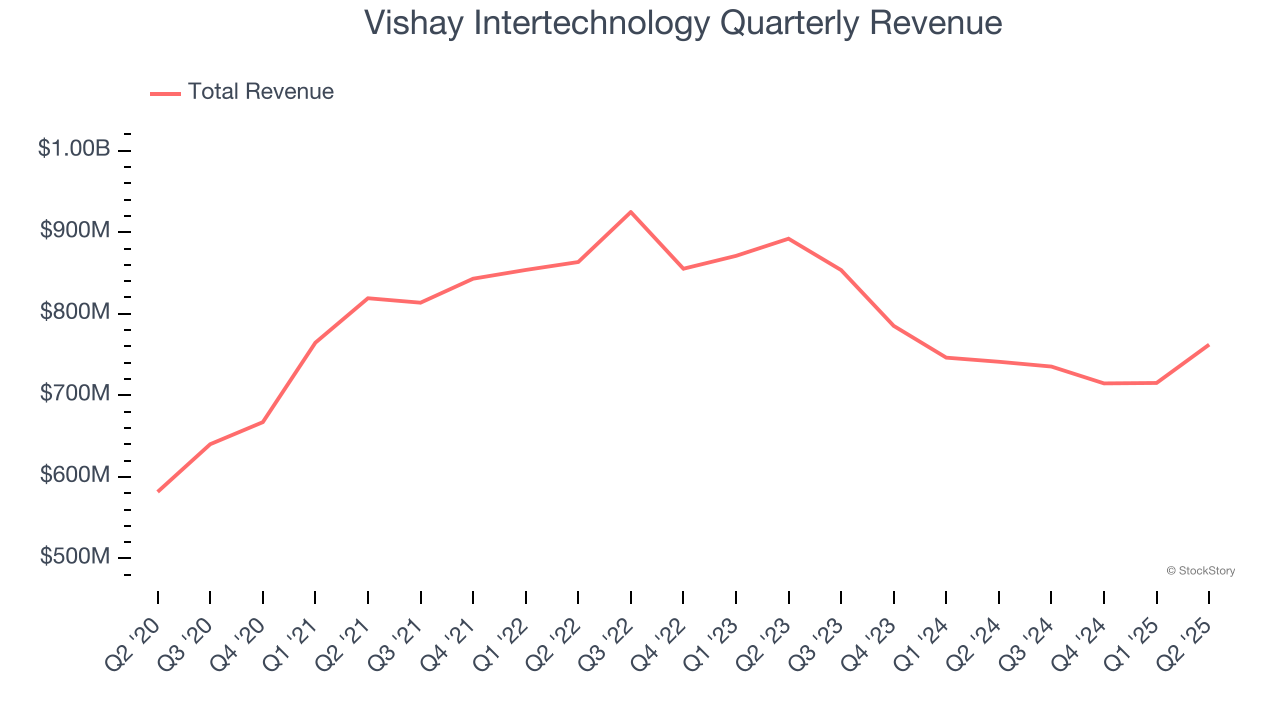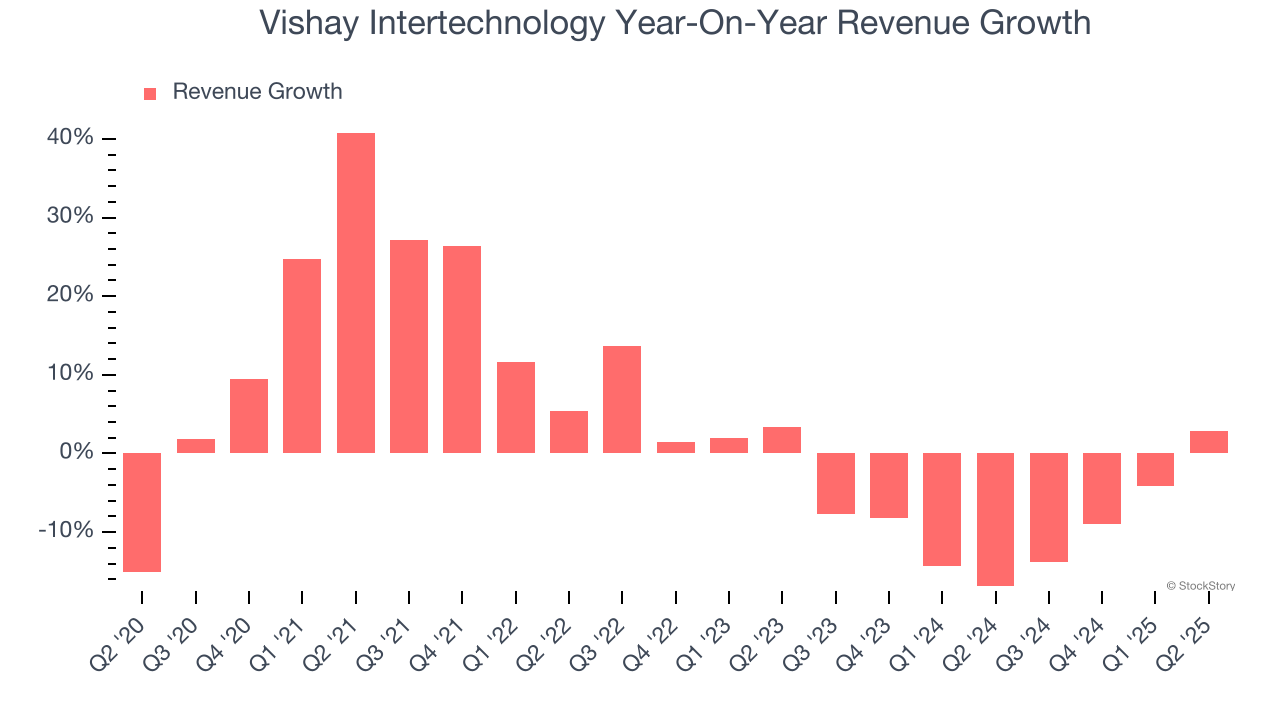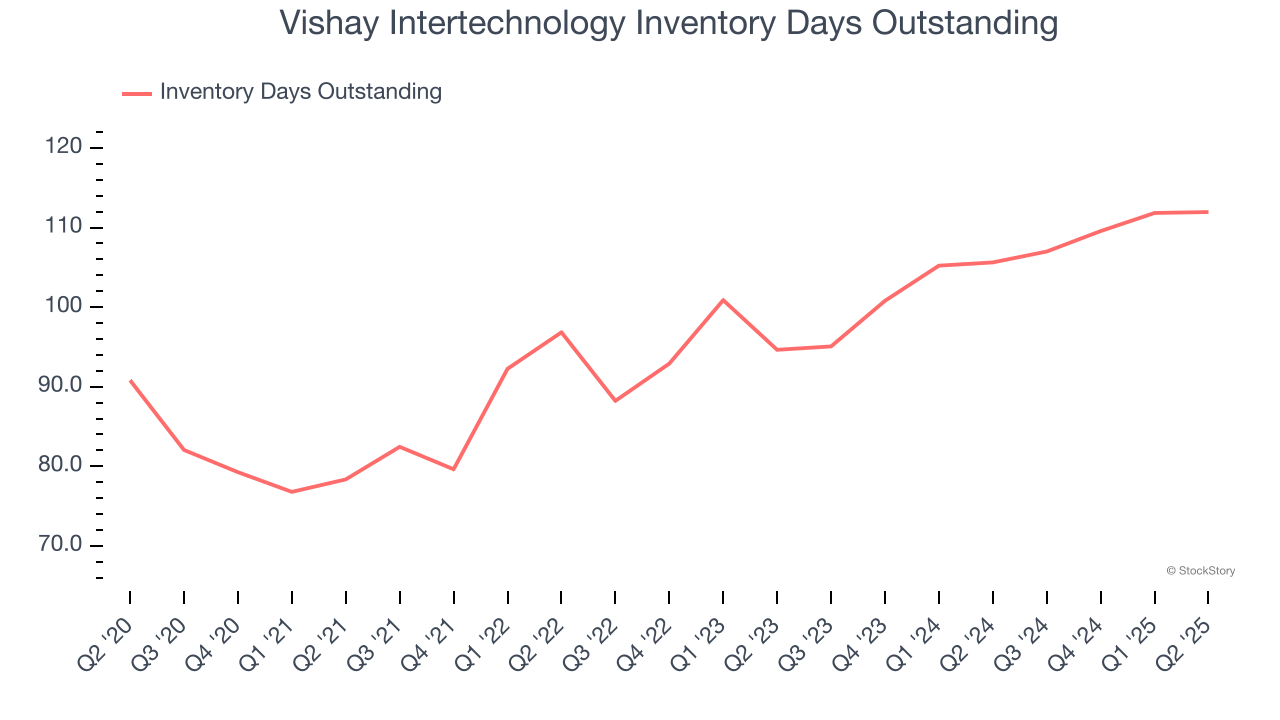
Semiconductor manufacturer Vishay Intertechnology (NYSE:VSH) met Wall Street’s revenue expectations in Q2 CY2025, with sales up 2.8% year on year to $762.3 million. On the other hand, next quarter’s revenue guidance of $775 million was less impressive, coming in 0.9% below analysts’ estimates. Its non-GAAP loss of $0.07 per share was significantly below analysts’ consensus estimates.
Is now the time to buy Vishay Intertechnology? Find out by accessing our full research report, it’s free.
Vishay Intertechnology (VSH) Q2 CY2025 Highlights:
- Revenue: $762.3 million vs analyst estimates of $763.1 million (2.8% year-on-year growth, in line)
- Adjusted EPS: -$0.07 vs analyst estimates of $0.02 (significant miss)
- Adjusted EBITDA: $63.52 million vs analyst estimates of $60.92 million (8.3% margin, 4.3% beat)
- Revenue Guidance for Q3 CY2025 is $775 million at the midpoint, below analyst estimates of $782.1 million
- Operating Margin: 2.9%, down from 5.1% in the same quarter last year
- Free Cash Flow was -$73.17 million compared to -$86.78 million in the same quarter last year
- Inventory Days Outstanding: 112, in line with the previous quarter
- Market Capitalization: $2.17 billion
“The promising signals we saw emerging at the beginning of the year contributed to a 7% sequential increase in revenue for the second quarter. We delivered growth for semis and passives, across each of our end markets, each region, and to distributors and EMS customers,” said Joel Smejkal, president and CEO.
Company Overview
Named after the founder's ancestral village in present-day Lithuania, Vishay Intertechnology (NYSE:VSH) manufactures simple chips and electronic components that are building blocks of virtually all types of electronic devices.
Revenue Growth
Reviewing a company’s long-term sales performance reveals insights into its quality. Any business can put up a good quarter or two, but many enduring ones grow for years. Regrettably, Vishay Intertechnology’s sales grew at a sluggish 3.8% compounded annual growth rate over the last five years. This fell short of our benchmark for the semiconductor sector and is a rough starting point for our analysis. Semiconductors are a cyclical industry, and long-term investors should be prepared for periods of high growth followed by periods of revenue contractions.

Long-term growth is the most important, but short-term results matter for semiconductors because the rapid pace of technological innovation (Moore's Law) could make yesterday's hit product obsolete today. Vishay Intertechnology’s performance shows it grew in the past but relinquished its gains over the last two years, as its revenue fell by 9.1% annually. 
This quarter, Vishay Intertechnology grew its revenue by 2.8% year on year, and its $762.3 million of revenue was in line with Wall Street’s estimates. Additionally, Vishay Intertechnology’s growth inflected positively this quarter, news that will likely give some shareholders hope. Company management is currently guiding for a 5.4% year-on-year increase in sales next quarter.
Looking further ahead, sell-side analysts expect revenue to grow 8.6% over the next 12 months, an improvement versus the last two years. This projection is above the sector average and suggests its newer products and services will catalyze better top-line performance.
Software is eating the world and there is virtually no industry left that has been untouched by it. That drives increasing demand for tools helping software developers do their jobs, whether it be monitoring critical cloud infrastructure, integrating audio and video functionality, or ensuring smooth content streaming. Click here to access a free report on our 3 favorite stocks to play this generational megatrend.
Product Demand & Outstanding Inventory
Days Inventory Outstanding (DIO) is an important metric for chipmakers, as it reflects a business’ capital intensity and the cyclical nature of semiconductor supply and demand. In a tight supply environment, inventories tend to be stable, allowing chipmakers to exert pricing power. Steadily increasing DIO can be a warning sign that demand is weak, and if inventories continue to rise, the company may have to downsize production.
This quarter, Vishay Intertechnology’s DIO came in at 112, which is 17 days above its five-year average, suggesting that the company’s inventory levels are higher than what we’ve seen in the past.

Key Takeaways from Vishay Intertechnology’s Q2 Results
We struggled to find many positives in these results. Its EPS missed and its revenue guidance for next quarter fell slightly short of Wall Street’s estimates. Overall, this quarter could have been better. The stock traded down 1.9% to $15.71 immediately after reporting.
Vishay Intertechnology’s earnings report left more to be desired. Let’s look forward to see if this quarter has created an opportunity to buy the stock. What happened in the latest quarter matters, but not as much as longer-term business quality and valuation, when deciding whether to invest in this stock. We cover that in our actionable full research report which you can read here, it’s free.
